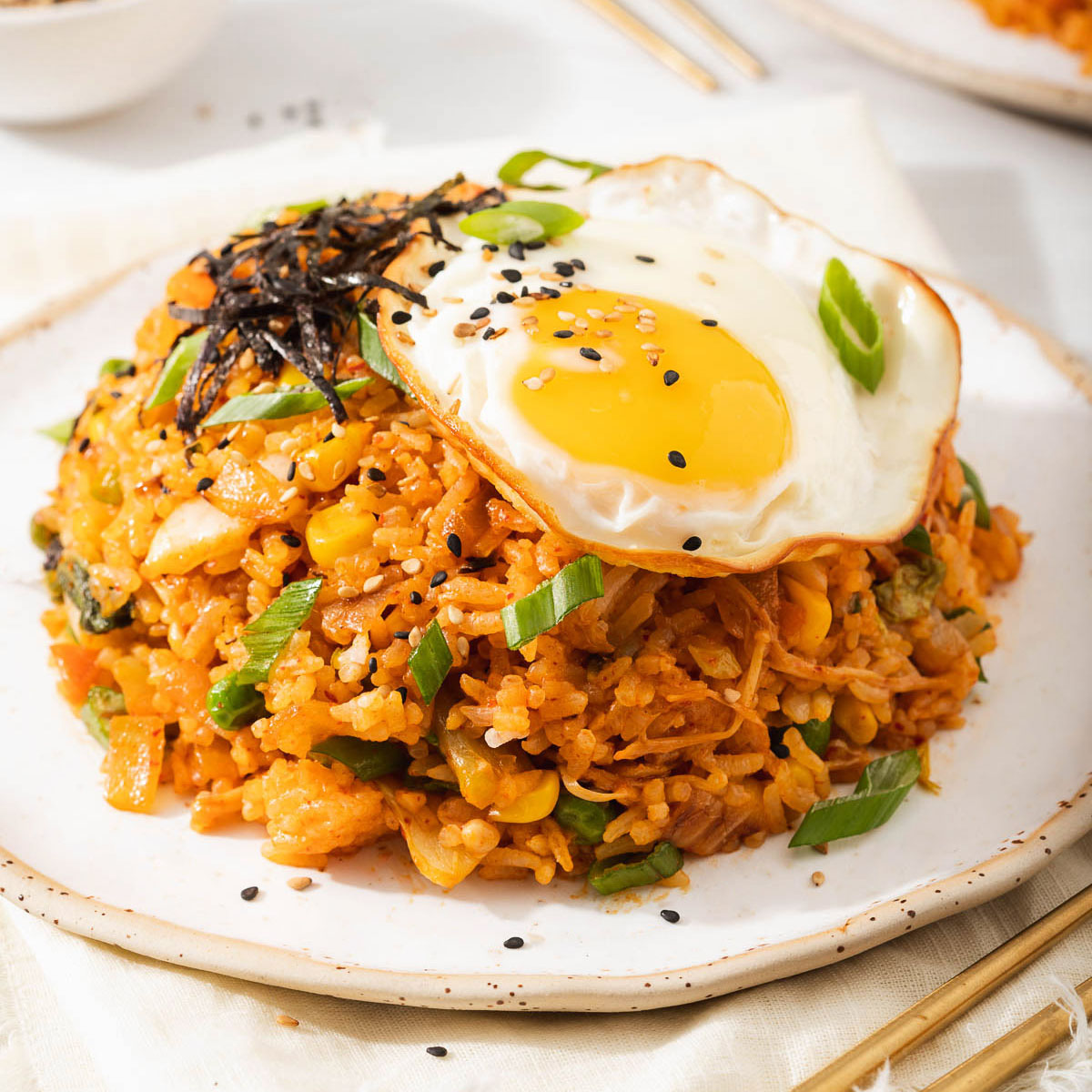Kimchi Bokkeumbap: A Spicy, Savory, and Satisfying Korean One-Pan Wonder
Related Articles
- A Journey Through Flavor: Unveiling The Secrets Of Central Asian Baklava
- A Journey Into The Delicious World Of Sate Kambing: A Comprehensive Guide
- A Journey Through Flavors: Unraveling The Secrets Of Paneer Butter Masala
- A Spicy Journey: Unveiling The Secrets Of Chili Crab (Singapura)
- A Deep Dive Into Batagor: The Indonesian Fish Cake Delights
Introduction
Discover everything you need to know about Kimchi Bokkeumbap: A Spicy, Savory, and Satisfying Korean One-Pan Wonder
Kimchi Bokkeumbap: A Spicy, Savory, and Satisfying Korean One-Pan Wonder

Kimchi bokkeumbap, also known as kimchi fried rice, is a beloved Korean dish that embodies the spirit of resourceful cooking. It’s a perfect example of how simple ingredients can be transformed into a delicious and satisfying meal. This article will delve into the fascinating history, explore the culinary techniques, and provide a comprehensive guide to creating your own perfect kimchi bokkeumbap.
From Humble Beginnings to Culinary Star:
Kimchi bokkeumbap is a shining example of how necessity can breed culinary creativity. It’s believed to have originated from the practice of utilizing leftover rice and kimchi, staples in Korean cuisine, to create a new and flavorful dish. The dish’s simplicity and adaptability make it a perfect meal for any occasion, whether it’s a quick lunch or a satisfying dinner.
The Essence of Kimchi Bokkeumbap:
The core of kimchi bokkeumbap lies in the harmonious blend of spicy kimchi, fragrant rice, and a variety of other ingredients. The dish’s signature flavor comes from the fermented kimchi, which adds a complex depth of umami and spice. The rice, ideally leftover and slightly dry, absorbs the flavors of the kimchi and other ingredients, creating a textural contrast.
A Journey Through Culinary Techniques:
Mastering kimchi bokkeumbap involves understanding the unique techniques that elevate it beyond a simple rice dish. Here’s a breakdown of the key elements:
1. The Art of Kimchi Preparation:
Kimchi, the star ingredient, requires a certain level of preparation before it can be incorporated into the dish. Here’s a step-by-step guide:
- Choosing the Right Kimchi: Opt for a kimchi that’s slightly fermented and has a good balance of spiciness and sourness. You can use kimchi from your local Korean grocery store or try making your own.
- Adjusting the Spice Level: If you prefer a milder flavor, rinse the kimchi under running water to remove some of the spiciness. Alternatively, you can chop the kimchi finely, allowing it to release less heat during cooking.
- Pre-cooking the Kimchi: Some recipes call for pre-cooking the kimchi before adding it to the rice. This helps to soften the kimchi and develop its flavors further.

2. The Key to Perfect Rice:
The rice used in kimchi bokkeumbap plays a crucial role in the dish’s texture and flavor.
- Leftover Rice is Ideal: The slightly dry texture of leftover rice is perfect for absorbing the flavors of the kimchi and other ingredients.
- Freshly Cooked Rice: If you’re using freshly cooked rice, make sure to let it cool completely before adding it to the pan.
- Toasting the Rice: Toasting the rice in a pan before adding the kimchi helps to create a crispy texture and enhance the overall flavor.
3. The Importance of Balance:
The secret to a truly delicious kimchi bokkeumbap lies in achieving the right balance of flavors and textures.
- The Spice Factor: The spiciness of the kimchi should be balanced by the sweetness of other ingredients, such as sugar or honey.
- Texture Play: The crispy rice should contrast with the soft texture of the kimchi and other ingredients.
- Umami Boost: Adding ingredients like soy sauce, fish sauce, or seaweed provides a rich umami flavor that complements the kimchi.

Crafting a Symphony of Flavors:
Kimchi bokkeumbap is a blank canvas for culinary creativity. You can experiment with different ingredients to create your own unique flavor profiles.
1. Beyond the Basics:
- Protein Power: Add protein to make it a complete meal. Options include thinly sliced pork belly, marinated beef, chicken, or tofu.
- Vegetable Variety: Enhance the dish’s nutritional value and texture by adding chopped vegetables like onions, garlic, green onions, mushrooms, or spinach.
- Egg-cellent Addition: A fried egg on top adds richness and a creamy texture.
- Seaweed Surprise: A sprinkle of toasted seaweed adds a salty and umami punch.
2. Exploring Regional Variations:
Kimchi bokkeumbap has evolved into regional variations with unique twists.
- Gyeonggi-do Style: This variation features a generous amount of pork belly and a slightly sweet flavor profile.
- Jeolla-do Style: Known for its use of fermented seafood, this version adds a complex umami depth.
- Gangwon-do Style: This variation often incorporates local ingredients like mountain vegetables and wild mushrooms.
Cooking Guidelines for a Perfect Dish:
Here’s a detailed recipe for a classic kimchi bokkeumbap:
Ingredients:
- 2 cups cooked rice (leftover or freshly cooked and cooled)
- 1 cup kimchi (chopped)
- 1 tablespoon vegetable oil
- 1/2 cup sliced pork belly or diced tofu
- 1/2 onion (sliced)
- 2 cloves garlic (minced)
- 1/4 cup green onions (chopped)
- 1 tablespoon soy sauce
- 1 tablespoon sugar
- 1 teaspoon sesame oil
- 1/2 teaspoon black pepper
- 1 egg (optional)
Instructions:
- Prepare the Ingredients: Chop the kimchi, slice the pork belly or dice the tofu, and mince the garlic. Chop the onion and green onions.
- Cook the Protein: Heat the vegetable oil in a large skillet over medium heat. Add the pork belly or tofu and cook until browned.
- Sauté the Vegetables: Add the onion and garlic to the skillet and cook until softened.
- Add the Kimchi: Stir in the kimchi and cook for 3-5 minutes, or until softened.
- Combine the Rice: Add the cooked rice to the skillet and stir gently to combine with the kimchi and other ingredients.
- Season and Cook: Add the soy sauce, sugar, sesame oil, and black pepper to the skillet. Stir well and cook for another 2-3 minutes, or until the rice is heated through.
- Finish and Serve: Garnish with chopped green onions. If desired, fry an egg and place it on top of the kimchi bokkeumbap. Serve immediately.
Tips for a Flavorful Kimchi Bokkeumbap:
- Experiment with Spice: Adjust the amount of kimchi or add a pinch of red pepper flakes to suit your taste.
- Don’t Overcook the Rice: Cook the rice just until heated through, avoiding overcooking which can result in a mushy texture.
- Don’t Be Afraid to Get Creative: Add your favorite vegetables, protein sources, or other ingredients to personalize your kimchi bokkeumbap.
- Serve it with Sides: Enjoy your kimchi bokkeumbap with a side of kimchi jjigae (kimchi stew) or a refreshing Korean salad.
Beyond the Plate: Cultural Significance and Culinary Identity:
Kimchi bokkeumbap is more than just a delicious dish. It represents the resourceful spirit of Korean cuisine and the deep cultural connection to kimchi. This dish is a testament to the ability to transform simple ingredients into a symphony of flavors, reflecting the cultural values of resourcefulness, adaptability, and a deep appreciation for fermented foods.
Conclusion:
Kimchi bokkeumbap is a testament to the beauty of simple yet flavorful cooking. It’s a dish that embodies the spirit of Korean cuisine, combining the unique flavors of kimchi with the versatility of rice. Whether you’re a seasoned chef or a novice cook, kimchi bokkeumbap is a dish that’s easy to make, endlessly customizable, and sure to satisfy your taste buds. So, gather your ingredients, embrace the spirit of creativity, and embark on a culinary journey with this iconic Korean dish.
Closure
Thank you for reading! Stay with us for more insights on Kimchi Bokkeumbap: A Spicy, Savory, and Satisfying Korean One-Pan Wonder.
Don’t forget to check back for the latest news and updates on Kimchi Bokkeumbap: A Spicy, Savory, and Satisfying Korean One-Pan Wonder!
Feel free to share your experience with Kimchi Bokkeumbap: A Spicy, Savory, and Satisfying Korean One-Pan Wonder in the comment section.
Keep visiting our website for the latest trends and reviews.






